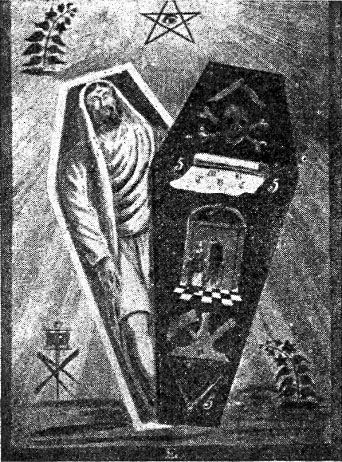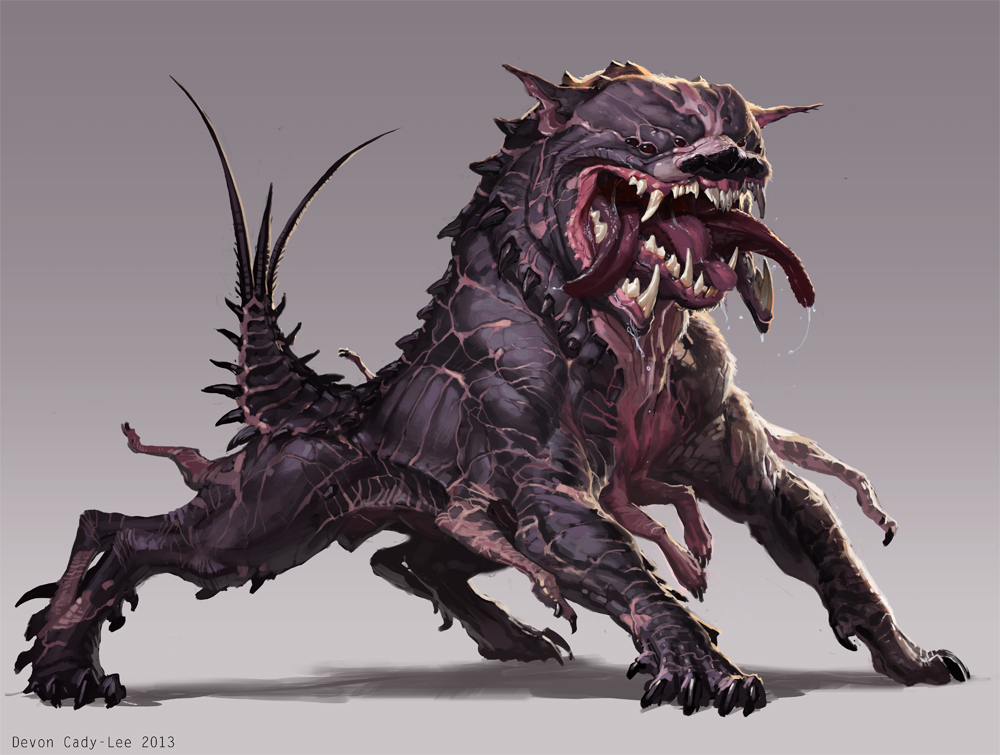Necronomicon [cont.]
The odd thing about the title is that in the discipline known as isopsephia where each Greek letter has a certain numerical value, Necronomicon adds up to 555 (N(50)+E(5)+K(20)+R(100)+O(70)+N(50)+O(70)+M(40)+I (10)+K(20)+O(70)+N(50)=555). Qabalistically, 555 is the number for darkness.
555 is found on the coffin of Hiram Abiff in Freemasonic art:


Strangely, when Hitler joined the German Worker’s Party or DAP that later became the Nazi Party, they were in the habit of putting a 5 in front of the member's actual number so that if you were the 20th person to join you were issued a membership card with your name and picture and the number 520 on it. Well, guess which numbered member Hitler was. That's right, #55 and on his DAP card is the number 555. Oddly, it is almost always the prefix used in telephone numbers on TV shows and movies.

But would the title be so cryptic and uncertain? As a Black Book being vigorously suppressed, it would have been given a cryptic title in those times. What’s remarkable is that a name with that much potential meaning to it would come to a man in a dream who did not speak Greek. That this man suffered from nightmares makes it that much more intriguing. One is tempted to wonder if perhaps someone or something was communicating things to Lovecraft as he slept. In fact, author/occultist Kenneth Grant believed precisely that and stated so in his book,
Aleister Crowley and the Hidden God. Crowley and Lovecraft were, in fact contemporaries. While the evidence appears to indicate that both knew of the other’s existence, neither actually mentions the other in their personal correspondence with colleagues and so the knowledge each had of the other was minimal at best.
Now, today, there are many Necronomicons out there. I have a few of them. There is H. R. Giger’s art book, there are the Skoobs Books editions of the
Necronomicon and
The R’lyeh Text (both of which the publishers and authors admit to being a blatant put on). The one we are mainly concerned with here is the so called “Simonomicon” which is the Avon Books version supposedly either written or revealed by a defrocked monk known only as Simon. Simon attributes the work to “the Mad Arab” but does not mention any Abdul Alhazred. It is a book of ceremonial magic containing information I have not encountered in any other grimoire. The incantations contained therein are largely in what seems to be Sumerian (Ancient Babylonian) although some words appear to be from other languages. For instance, the word “zelig” is used which is German for “holy” but also “silly” or “crazy.”
The book is arranged such that the magician or wizard is required to leave his or her body behind and travel in the spirit or, as the New Agers would say, astrally. The book refers to it as “the Walking.” One must approach the seven gates of the zonei in succession. The first gate is that of Nanna (the moon), then Nebo (Mercury), Inanna (Venus), Shammash (the sun), Nergal (Mars), Marduk (Jupiter), and, finally, Ninib (Saturn). Each zonei has its own color, number, seal and metal as well as a specific step on “the ladder of lights.” Each zonei has a seal and the wizard must engrave it on a plate made of the metal that pertains to that zonei and do it at a time when that planet is exalted in the heavens so that its light falls upon it.
The wizard must have an altar with images of the zonei and offerings must be made and incense burnt in a brazier. The altar is enclosed in a magic circle which serves as a boundary line from outside forces. During the Walking, as the wizard advances up the Ladder of Lights, he must approach a gate wearing the seal of the zonei of that gate. There are all kinds of instructions about the position and phase of the moon when the Walking starts and it must be done in stages. The wizard approaches the first gate, utters the invocation and falls back to earth. This first gate would be that of Nanna. During the next Walking, one would approach the gate of Nebo and do the same but first passing through the gate of Nanna. One cannot pass a gate if a previous gate has not yet been opened, e.g. one cannot jump up to the gate of Ninib if any of the previous six gates have not been opened. The invocations must be spoken flawlessly. If a mistake is made, the gatekeeper slams the gate shut and the wizard falls back to earth. One cannot progress to the next gate until the current one has been opened and passed.
Before a Walking is attempted one must have protection or the idimmu (hungry scavenging demons) may devour ones unoccupied body. The magic circle affords protection but the appearance of those that wait outside are said to be so loathsome and blasphemous that the very sight of them is literally maddening and so one must also invoke the fire god and the Watcher. Of the fire god, little is said other than the proper invocation. Of the Watcher, much is written for a simple mistake will cost the magician his life. To summon the Watcher, one must have the Copper Dagger of Inanna, a sword and a bowl. The bowl must be engraved with three specific symbols with a stylus and filled in with dark ink. The proper sacrifice must be made in the bowl. One stabs the sword into the ground, raises the Copper Dagger of Inanna and recites the invocation of the Watcher. Everything MUST be performed perfectly else the Watcher itself will devour you. When the Watcher appears (always outside the circle), you must instruct it what it is to watch—specifically your body—and destroy anything that approaches too close to the Magic Circle, human or otherwise. The Watcher will do your bidding but does not care what it watches as long as the proper sacrifices have been made. Failure to do this is an instant death for the wizard. After falling back to earth, the wizard’s body revives and he then must strike the hilt of the sword with his left hand and recite: “BARRA MASS SSARATU! BARRA!” And the Watcher will depart. The wizard cannot leave the circle until he gives the Watcher leave or else the Watcher will devour him. Likewise, the sword must be firmly thrust into the earth during the Walking. If it should fall over of its own accord or the wizard should inadvertently touch it before the ceremony is ended, the Watcher will instantly depart and leave the wizard unguarded from the sight of those that wait without.
What is the Watcher? The Mad Arab states, “The Watcher comes from a race different from that of Men and yet different from that of the Gods…” Of its appearance, the Mad Arab writes: “…the Watcher sometimes appears as a great and fierce Dog, who prowls about the Gate or the Circle, frightening away the idimmu who forever lurk about the barriers, waiting for sacrifice. And the Watcher sometimes appears as a great and noble Spirit, holding aloft the Sword of Flames, and even the Elder Gods are awed thereby. And sometimes the Watcher appears as a Man in a Long Robe, shaven, with eyes that never lose their stare.”

In 1959, author C. B. Colby put out a book titled
Strangely Enough which is a collection of yarns that deal mainly with weird or unexplained phenomena. Some of the stories have a basis in fact, some are clearly just legend. Nothing in the book can or should be taken as unassailable fact. They are just fun, little stories to read to pass the time. One story is called “The Man in the Golden Armor” and concerns a World War I battle that took place August 28, 1914 at some location Colby does not specify between the British and German armies. The Royal Field Artillery was attempting to defend a hill as a much larger force of German army bore down on them. The German cavalry charged up the hill when suddenly a luminous cloud appeared before them and when the light died away, they saw what Colby described as “…the figure of a tall man with yellow hair and golden armor, astride a white horse. The man’s uplifted arm held a mighty sword.” A wounded RFA soldier told an English nurse, Phyllis Campbell, that the apparition was so frightening and awesome that the German army turned and fled in a panic. Other men who had been nearby during the battle also told Campbell the same story. A month later, a German nurse in Potsdam wrote about German officers telling her that, while attempting to take a hill, the image of a huge man on a white horse appeared suddenly and scared their horses so badly that the animals turned and ran, ignoring all orders to stop. This sounds like a variation of the “Miracle of Mons” story that allegedly occurred August 24, 1914 where “angelic warriors” in the form of longbowmen appeared from a luminous cloud and helped a small army of British soldiers defeat a larger army of Germans. The story was made up by Scottish author, Arthur Machen (once a member of the Hermetic Order of the Golden Dawn). But the description Colby gives of the apparition sounds quite similar to the Watcher. Colby couldn’t have copied it from the Simonomicon but is it possible that the author of the Simonomicon borrowed it from Colby? Or is it just coincidence?








 Hybrid Mode
Hybrid Mode